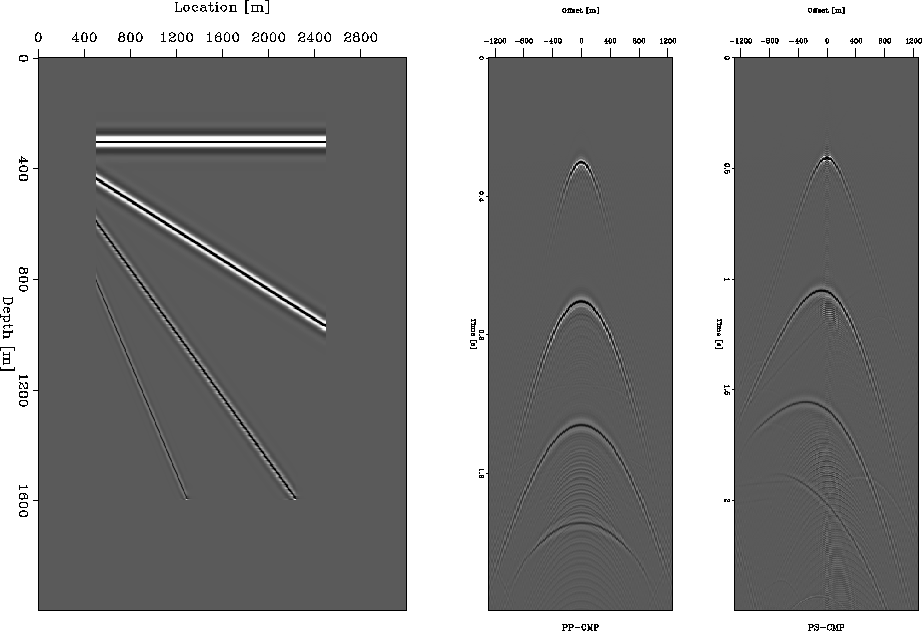![[*]](http://sepwww.stanford.edu/latex2html/cross_ref_motif.gif) . Note, that both PP and PS sections,
had the same SODCIG.
. Note, that both PP and PS sections,
had the same SODCIG.
![[*]](http://sepwww.stanford.edu/latex2html/cross_ref_motif.gif) shows on the left the reflectivity model, and
on the middle and right panels, one single mode PP CMP gather and one converted
mode PS CMP gather.
The PP-CMP gather presents four reflection hyperbolas, all of them
centered at zero-offset. The PS-CMP gather
also presents the four reflection hyperbolas, corresponding to the same
events as in the PP-CMP gather, however, they are not centered at
zero-offset, as it is expected for the coverted-mode case. Also, the
time axis for both synthetic data sets is different. The events on
the PS CMP gather take longer to arrive, this is also a characteristic
for the converted-mode case. The polarity flip is not included in this
model, since it has been already discussed by Rosales and Rickett (2001b).
shows on the left the reflectivity model, and
on the middle and right panels, one single mode PP CMP gather and one converted
mode PS CMP gather.
The PP-CMP gather presents four reflection hyperbolas, all of them
centered at zero-offset. The PS-CMP gather
also presents the four reflection hyperbolas, corresponding to the same
events as in the PP-CMP gather, however, they are not centered at
zero-offset, as it is expected for the coverted-mode case. Also, the
time axis for both synthetic data sets is different. The events on
the PS CMP gather take longer to arrive, this is also a characteristic
for the converted-mode case. The polarity flip is not included in this
model, since it has been already discussed by Rosales and Rickett (2001b).
After wave-equation migration with the correct velocity model, the
image is perfectly focused at zero subsurface offset, displayed
on the left panel of Figure ![[*]](http://sepwww.stanford.edu/latex2html/cross_ref_motif.gif) . Note, that both PP and PS sections,
had the same SODCIG.
. Note, that both PP and PS sections,
had the same SODCIG.
The middle and right panels of Figures ![[*]](http://sepwww.stanford.edu/latex2html/cross_ref_motif.gif) present the result of the
transformation from SODCIGs into the single-mode ADCIG (center panel), and
the the converted-mode ADCIG (right panel).
It is possible to observe that the
angle range (i.e. before the start of the artifacts due to the transformation in the
Fourier domain) for the converted-mode ADCIG is longer than for the single-mode
ADCIG, as it is expected, since the angle-information contains both
the incidence and reflection angle information.
present the result of the
transformation from SODCIGs into the single-mode ADCIG (center panel), and
the the converted-mode ADCIG (right panel).
It is possible to observe that the
angle range (i.e. before the start of the artifacts due to the transformation in the
Fourier domain) for the converted-mode ADCIG is longer than for the single-mode
ADCIG, as it is expected, since the angle-information contains both
the incidence and reflection angle information.
 |
 |